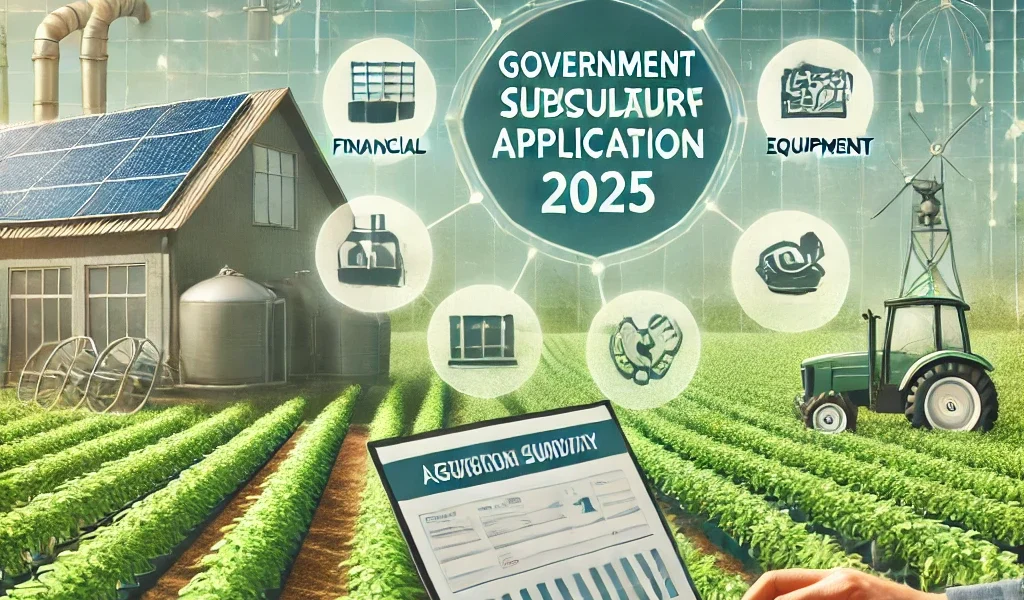Agriculture subsidies are financial assistance programs provided by the government to support farmers, agribusinesses, and rural development. These subsidies help reduce the cost of production, encourage sustainable farming, and boost the overall agricultural economy. If you are a farmer or an agribusiness owner looking to apply for subsidies, this guide will walk you through the step-by-step process.
Understanding Agriculture Subsidies
Agriculture subsidies come in different forms, such as direct financial grants, tax exemptions, low-interest loans, and price support programs. These subsidies are designed to assist farmers in acquiring necessary resources like seeds, fertilizers, equipment, irrigation systems, and sustainable farming technologies.
Types of Agriculture Subsidies
- Seed and Fertilizer Subsidies – Discounts on certified seeds and fertilizers to promote high-yield crops.
- Irrigation and Water Conservation Subsidies – Assistance for setting up irrigation systems, rainwater harvesting, and water-efficient farming.
- Farm Equipment and Machinery Subsidies – Financial aid for purchasing tractors, harvesters, and modern agricultural tools.
- Organic Farming and Sustainable Agriculture Grants – Support for transitioning to organic farming and eco-friendly practices.
- Livestock and Dairy Farming Subsidies – Financial assistance for purchasing cattle, poultry, and dairy farming equipment.
- Crop Insurance and Risk Management Programs – Government-backed insurance policies to safeguard farmers from natural disasters and crop failure.
- Export and Market Development Grants – Financial aid for farmers and cooperatives to export their produce and expand into new markets.
Step-by-Step Guide to Applying for Agriculture Subsidies
Step 1: Research Available Subsidies
The first step in applying for an agriculture subsidy is identifying the programs that match your farming needs. Governments offer different subsidies at the national, state, and local levels. You can find information on official government websites, agriculture departments, and local cooperative offices.
Where to Find Agriculture Subsidies:
- Official government agriculture ministry websites
- Local agricultural extension offices
- Farmer associations and cooperatives
- Agricultural development banks
Step 2: Check Eligibility Requirements
Each subsidy program has specific eligibility criteria. These may include:
- Type of farming activity (crop farming, livestock, organic farming, etc.)
- Landholding size and location
- Financial status of the farmer or agribusiness
- Compliance with government-approved farming methods
- Registration with agriculture departments or cooperatives
It is essential to carefully read the eligibility criteria before applying to ensure you meet the necessary requirements.
Step 3: Gather Necessary Documents
Once you have determined your eligibility, the next step is to prepare the required documents. The common documents needed for subsidy applications include:
- Identity Proof: Government-issued ID or farmer registration certificate
- Land Ownership or Lease Documents: Proof of farmland ownership or lease agreement
- Bank Account Details: Account information for subsidy transfer
- Business Registration (if applicable): For agribusinesses applying for subsidies
- Project Proposal (if required): For larger grants related to infrastructure or technology adoption
Step 4: Submit the Application
Most governments offer both online and offline methods for subsidy applications. Depending on the program, you can:
- Apply Online: Visit the official government website, fill out the subsidy application form, upload documents, and submit.
- Apply Offline: Visit the nearest agriculture department office, collect a physical application form, fill it out, and submit it along with required documents.
Step 5: Follow Up on Application Status
After submission, keep track of your application status. Most government portals allow you to check your application progress online. If applying offline, you can visit the respective department or contact helplines for updates.
Step 6: Receive Subsidy Approval and Funds
Once your application is reviewed and approved, the subsidy amount will be disbursed either directly into your bank account or through agricultural cooperative banks. Some subsidies may also be provided in the form of vouchers for specific agricultural inputs.
Common Mistakes to Avoid When Applying for Agriculture Subsidies
- Incomplete Documentation: Ensure all necessary documents are submitted to prevent delays or rejection.
- Missing Deadlines: Many subsidy programs have specific application windows; apply on time.
- Providing Incorrect Information: Double-check all details to avoid errors that could lead to disqualification.
- Ignoring Follow-ups: Stay updated on your application status to address any queries from authorities.
- Not Utilizing Subsidy Properly: Ensure the funds are used as per the subsidy’s intended purpose to maintain eligibility for future benefits.
Benefits of Agriculture Subsidies
- Lower Farming Costs: Subsidies help farmers reduce expenses on seeds, fertilizers, and machinery.
- Increased Productivity: Financial support allows farmers to adopt modern technology and improve yield.
- Risk Mitigation: Crop insurance and disaster relief subsidies help protect against unpredictable losses.
- Encourages Sustainable Farming: Many subsidies promote organic and environment-friendly farming practices.
- Improves Rural Economy: Government support strengthens the agricultural sector, creating jobs and boosting local economies.
Conclusion
Applying for agriculture subsidies can significantly benefit farmers and agribusiness owners by reducing costs, improving productivity, and ensuring sustainable farming. By following the step-by-step process outlined in this guide, you can successfully apply for and receive government support.
Make sure to stay informed about the latest agriculture subsidy programs available in your region and take advantage of government support to grow and sustain your farming business.




